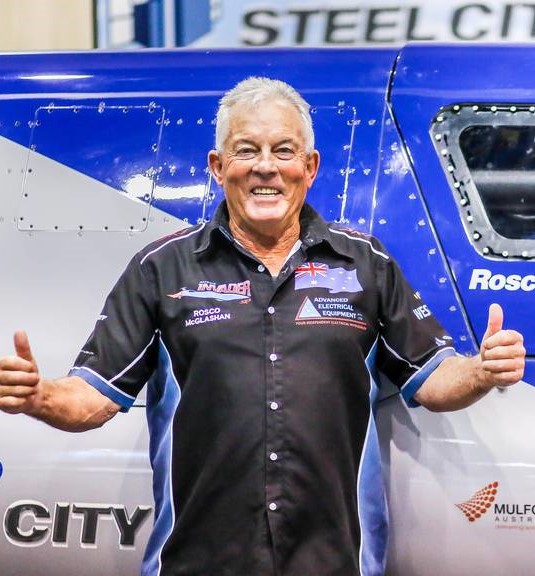Rosco McGlashan OAM

Drag Racing Legend & Australian Land Speed Record Holder
Rosco McGlashan grew up tinkering with anything that had wheels, trying to go faster than the other kids on the block. When he was 12, the late Donald Campbell visited Australia with his Bluebird turbine-powered land speed racer. Rosco was so intent on building and racing a car faster than Campbell’s, that he quit school and went working in Western Australia’s far north. With an age adjustment from 12 to 16, he managed to start pursuing his life’s goal of a racing career, and his land speed ambitions.
His desire to beat Campbell’s world land speed record of 403 mph, has taken him many long years. His first motor racing break came in 1968 when he was given a drive in a Pro Stock drag car. Rosco was an instant success story in drag racing and has earned his living in this field for many years.
Some of his high-speed exploits can be seen on Rosco’s past machines, which includes a V8 motorcycle, rocket powered world record go-kart (253 mph), a jet dragster, which achieved 315 mph, jet funny cars and even a jet powered truck.
Setting The Australian Land Speed Record
In 1993, Rosco with the help of 25 professionals, all volunteers, assembled his first Land Speed Racer known as “Aussie Invader 2”. This car was powered by a 36,000 hp Mirage jet fighter engine. This racer was a culmination of 10 years of blood, sweat and tears. On its first run, Aussie Invader 2 reached a speed of 450 mph, but the record run could not be backed up. Track conditions and bad weather forced the team away from Lake Gairdner in South Australia and back to their base in Western Australia, to prepare for their next attack on Donald Campbell’s Australian land speed record of 403 mph.
1994 saw a revamped Aussie Invader 2 and an essential personnel-only race team. Rosco McGlashan became the “The Fastest Aussie On Earth” with an official 500 mph two-way pass. Not being content to settle with an Australian record, Rosco wanted to have a go at the world land speed record, but a massive storm put pay to that.
Rosco and the team returned to Lake Gairdner in 1995 to attack Richard Noble’s world land speed record of 633 mph (1,017 km/h). The track was in very poor condition and at close to 600 mph Aussie Invader 2 broke through the salt surface and tram-lined through the timing equipment, 200 metres away from the track’s measured mile. Aussie Invader 2 was a write-off. They returned to Perth, and immediately the team went to work on a new, sleeker and more powerful car, Aussie Invader 3.
The Aussie Invader team wanted to return to Lake Gairdner in South Australia in 1996. Torrential rain put pay to that and before they could return again the British in their twin jet engine car Thrust SSC ran 763 mph, creating the biggest jump in the history of the land speed record, with their car going supersonic on the way. This effectively made Aussie Invader 3 redundant.
Rosco got a chance to run Aussie Invader 3 in 2000 and after some test passes, the car recorded a peak speed of 638 mph (1,027 km/h) which was faster than Richard Noble’s previous record at 633 mph.
Aussie Invader 5R Is Born
After witnessing the success of Spaceship One’s historic flight, Rosco knew he needed a BIG rocket motor to set his next record and worked with Peter Beck, CEO of New Zealand’s famous Rocket Lab to build a bi-propellant motor capable of exceeding the holy grail of auto racing … 1000 mph (1600 km/h).
After many years of planning and testing, different designs and propulsion formats, work commenced on building Aussie Invader 5R in 2009. It has taken 15 years so far and the car’s build is complete. We are now entering Phase 2, the rocket engine development and testing.
Aussie Invader 5R is unique in design, being built to have a dry weight of 6.2 tonnes and will go from a standing start to 1,000 mph (1,600+ km/h) in about 20 seconds. As the car enters the measured mile, the rocket is throttled back, not wanting to exceed the magic 1,000 mph barrier by more than 25 mph, to limit the max rpm on our wheels and bearing safety rating.



